Charles E W Bean, Diaries, AWM38 3DRL 606/248/1 - 1917 - 1931 - Part 11

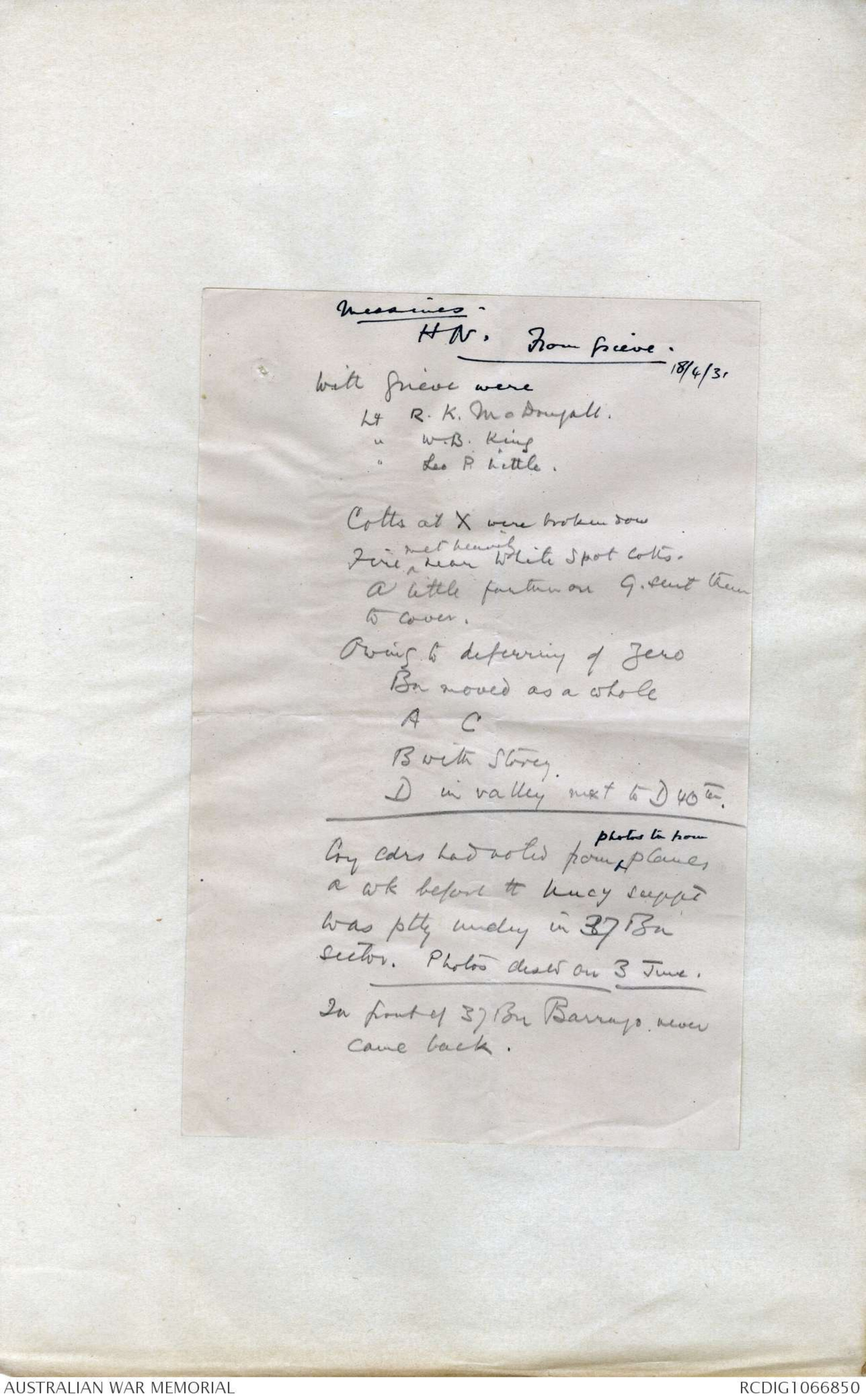


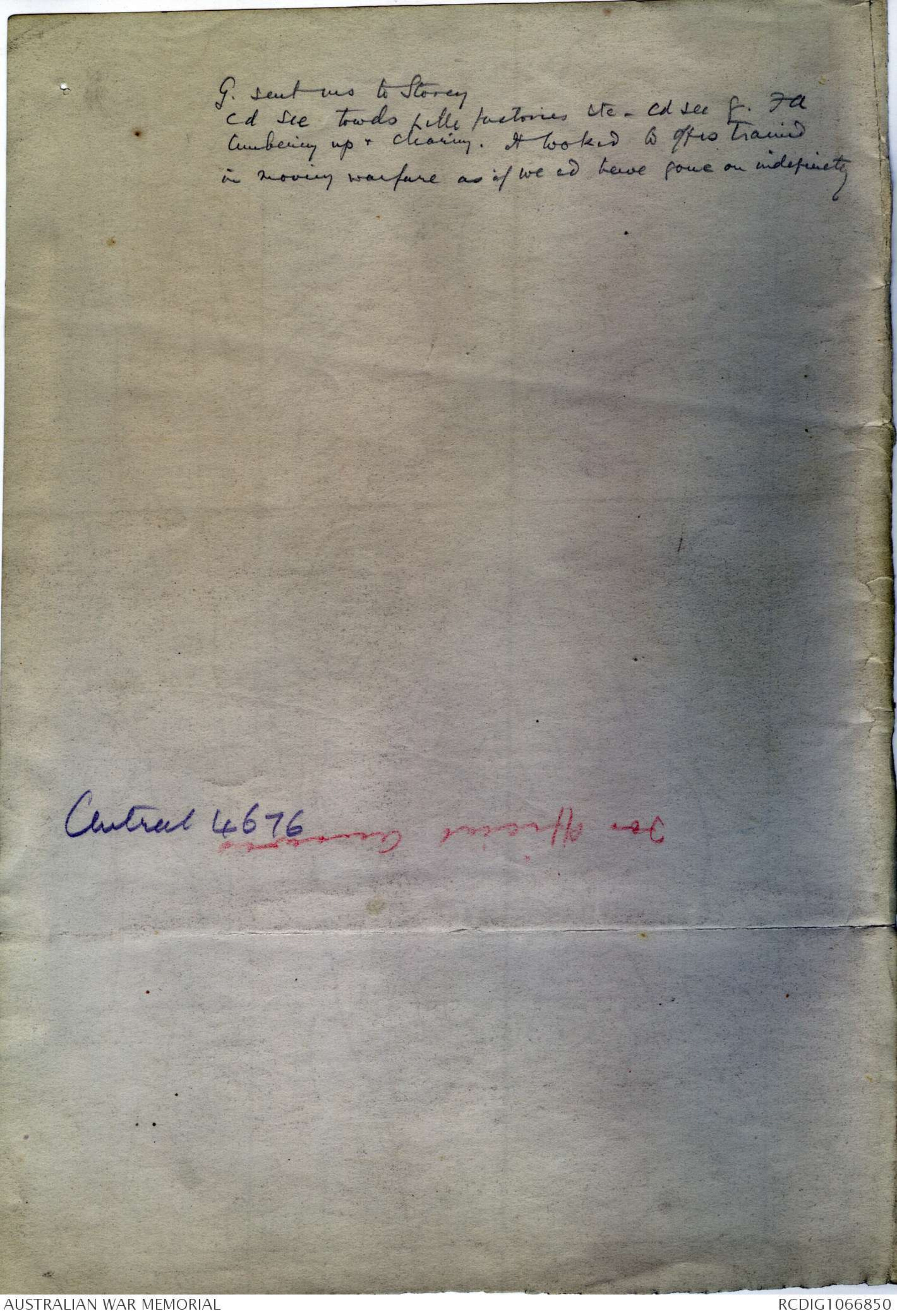
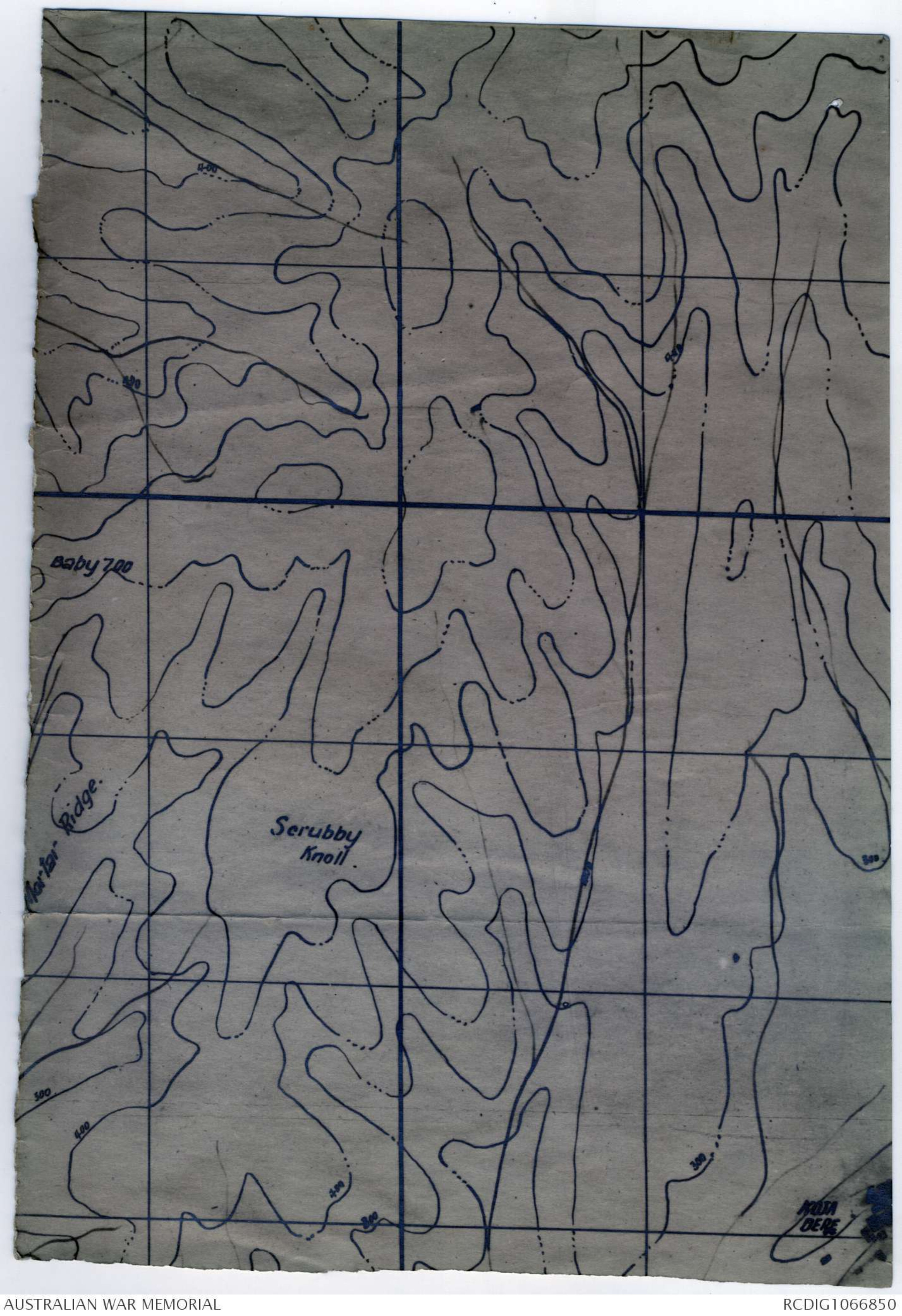
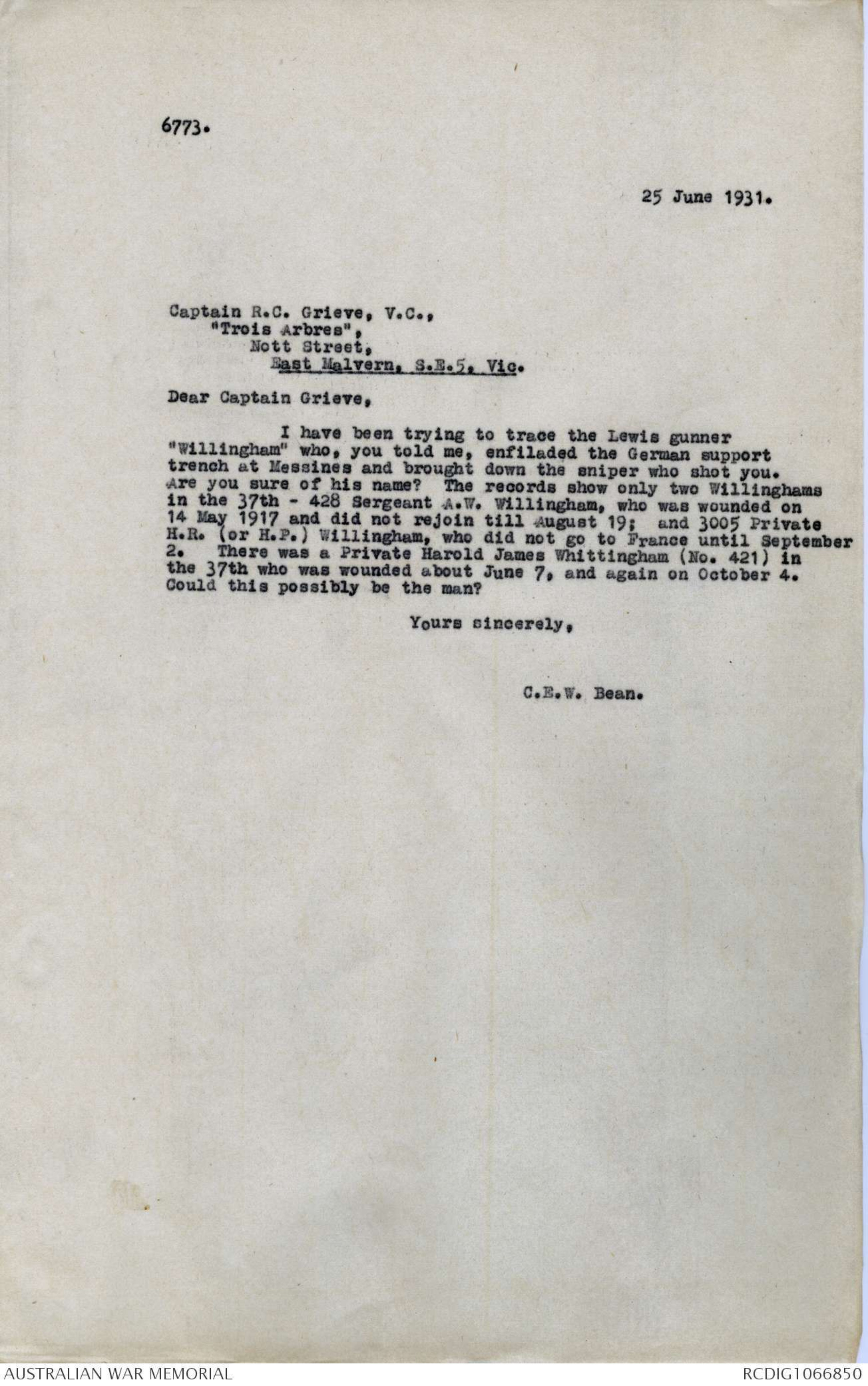
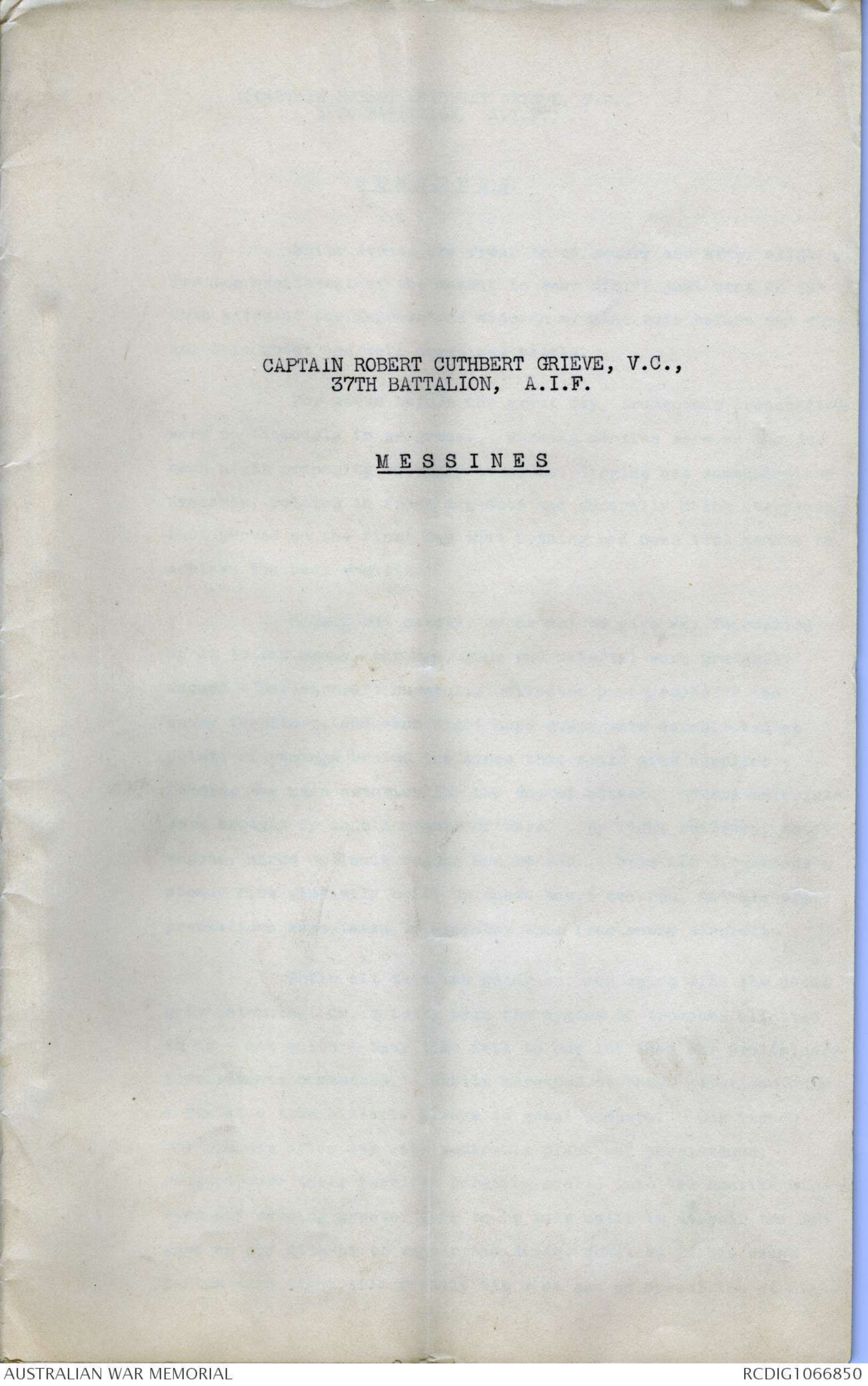
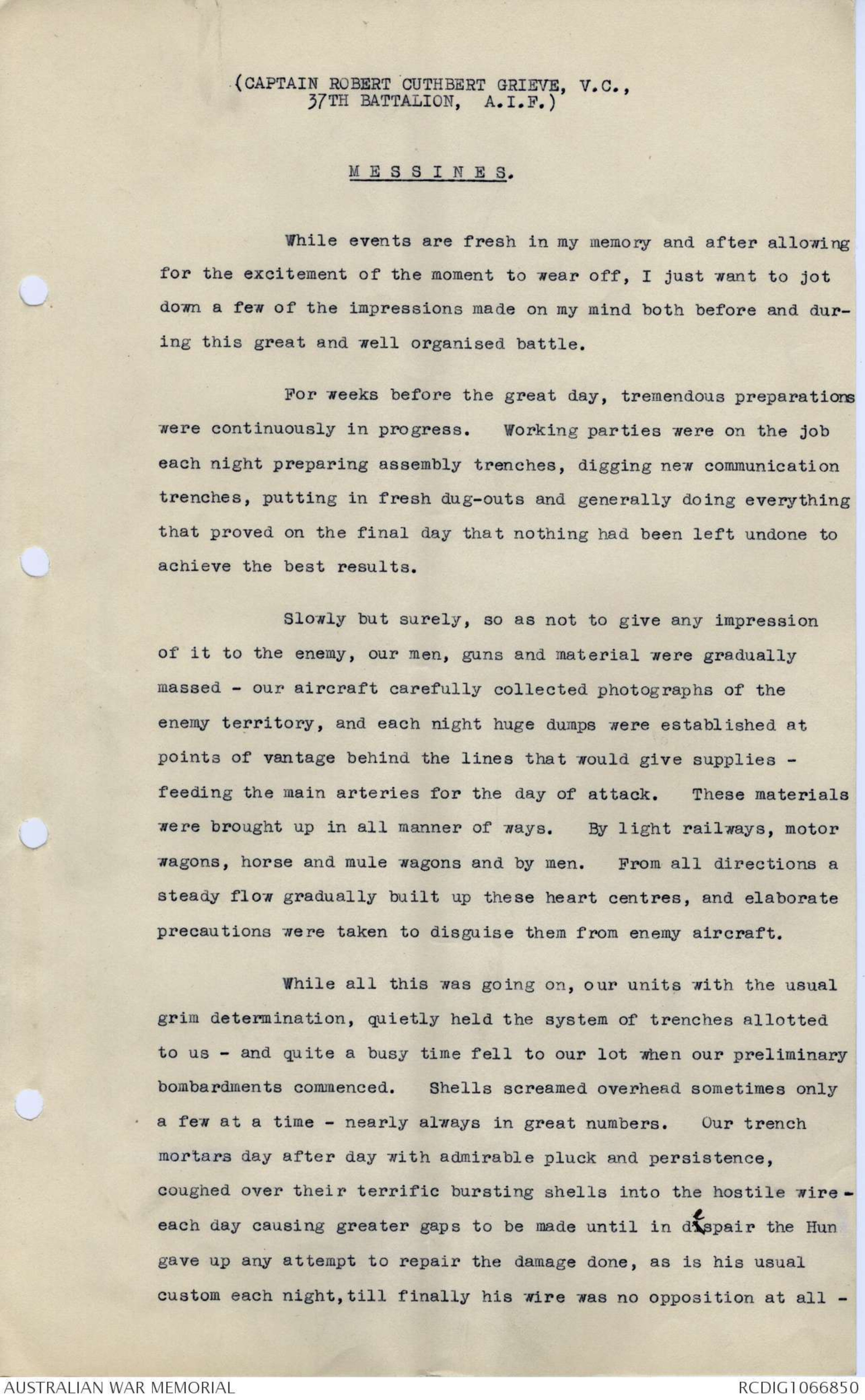
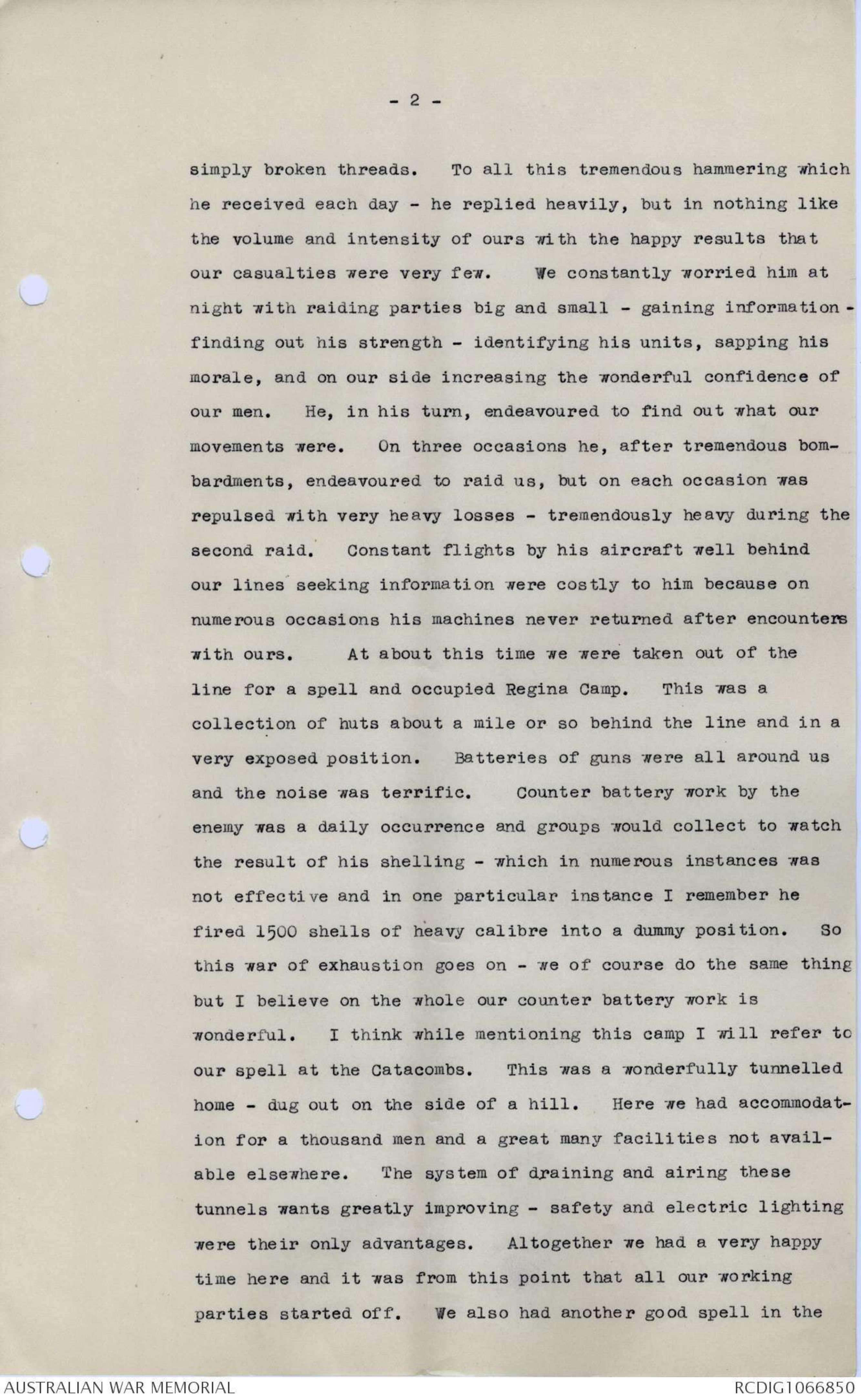
MC 500 /162.
37th Battn A.I.F.
Amendments to Instructions to M.O.
Consequent upon further instructions being received
the following amendments to the undermentioned forms
in the "Instructions for the attack on the enemy on 'Z'
day by the 37th Battn A.I.F. and portion of the 40th
Battn A.I.F. attached are rendered necessary.
1o. For para 8. ARTILLERY Support read.
'THE INSTRUCTIONS contained in 10th A.IB. P.I.M.O
No 6. date June 4th 1917, "ARTILLERY ACTION" including
(a) advancing barrage.
(b) S.O.S. action.
(c) rate of fire.
(d) Times of standing Barrage.
(E) Howitzer barrages.
(F) Hostile retaliation.
Sketch map showing barrages is issued herewith
for A.B.C & D Coys 37th Battn and D Coy 40th Battn. maps are
not available for issue from this office to other
units to which this order was sent.
2o For para 13. OBJECTIVES of & ACTION by COMPANIES
read - "The following shows the objectives of and
action to be taken by Coys after advancing at
Z + 10 hours.
'C' Coys 37th Battn at Z + 10 hours 20 minutes C Coy 37th
captures and consolidates the line UNCANNY TRENCH
from the Bde boundary at U.4.a.35.53 inclusive
and along the GREEN LINE to U.4.c.45.55. The C.O. C. Coy
will form a double BOMBING BLOCK at the junction of
UNDULATING SUPPORT and UNDULATING TRENCH.
'A' Coy 37th:- at Zero + 10 hrs 35 mins 'A' Coy 37th Captures, Consolidates
the line from HUNS WALK at U.4.a.95.63. inclusive near the
junction of UNDULATING SUPPORT and UNDULATING TRENCH at
U.4.a.66.20. The O.C. A Coy will establish a strong point
in rear of his Coy. frontage. One machine gun and
one Trench mortar will be allotted to A Coy.
The Trench mortar must be so placed that it can assist
the double bombing block to be formed by 'C' Coy in
addition to performing its functions with the strong
point.
D Coy 37th - D Coy 37th will consolidate the GREEN LINE from
U4.C.45.85 to U.4.C.18. 26 inclusing 6.c. D Coy will form
a strong point in rear of his Coy. frontage. It will be
allotted 1 M.G. and one T.M.
D Coy 40th. - D Coy 40th Battn will consolidate on the GREEN LINE
from u.4.C.18.26 to and inclusive of the DOUVE RIVER at U.1.oc.1.0758.
A Bombing Block will be established in UNGODLY AV.
It will be noticed that a change of direction will
need to be made by Coys in order to enable them to capture
and consolidate the GREEN LINE. Great care will therefore
be necessary while following the barrage to see that
direction in not lost and that Coys. do not overshoot
their objectives. Careful reconnaissances by Comdrs
and their subordinates before moving to the capture of
objectives and before giving final instructions will
result in mistakes being avoided.
'B' Coy 37th Battn. B Coy 37th under Major C.B. STORY will form
the reserve ※ all officers will mark their maps
clearly with lines showing the objectives to be
taken. The limits of Bde and Battn boundaries
& Coy frontages will also be shown on such
maps to facilitate reference.
JA Clarebrough Capt
Adjutant 37th. Battalion
Messines.
HN. from Grieve.
18/4/31
With Grieve were
Lt R.K. McDougall.
" W.B. King
" Leo P. Little.
Cotts at X were broken row
Fire ^met heavily near White Spot Cotts.
A little further on G. sent them
to cover.
Owing to deferring of Zero
Bn moved as a whole
A C
B with Storey.
D in valley next to D 40th.
Coy Cdrs had noted from ^photos tn from planes
a wk before tt necy suppt
was ptly undwy in 37 Bn
sector. Photos distr on 3 June.
In front of 37 Bn Barrage never
came back.
11 a.m. Sat. Messines, 37Bn.
10526 Central - From 9 o'clock.
H. N. From Capt Grieve 18/4/31
Lt Little gassed
Lt McDougall hit.
TM Bty blown out by howitzer shell.
Grieve ws shot by a sniper up a small tree as he ws getting the l. flank up.
A L. Gr, Willingham, put a L. G burst thro' tree & sniper fell.
First m.g. fire was met in wire & shell holes ½ way across. It wiped out ½ Coy,
incldg all other offrs. Going on meant Exterminatn.
G. Cd see m.g firing, & it had limited traverse -
coming from pill box inside an old hut. w
entrance from trench - a S.P. - loopholed but
w limited traverse - concrete steps down - &
m.g. ws firing thro loophole. At jn of uncanny
& undulating. Hedge close in front. Cd see flash
G had a bag of Mills & picked his way by throwing
& running ahead when bomb burst. G. got one
burst so close tt it silenced guns. Then put
two mills thro' loophole to make sure.
He then went round & had a look - m.g. & grs
there. Other Germans were under
Diagram - see original document
influence of our barrage.
Grieve beckoned Coy on.
Fraser ws knocked out a little after the T.M. He had tried to
suppress a m.g. Farther back by VG fire
G. when he saw m.g. in blockhouse, & also Gs
moving in Undultg Suppt tried to get TM &
V.G. & found TM blown out but got Fraser.
Fraser was blown out as he got his gun into
actn. Mended his V.G. w a bit of barbed wire.
Fraser is at
Korumburra - Gippsland. (Ring up Gippsland. & Northern)
G. ws ^beckoning, getting l. flank more up to 4 Div. when he ws winged
He ws fixed up & cd see movt along Undg Suppt.
sent same L.g. - Willingham – who enfilading
suppt & wiped them out. Gs were on move back.
This ws on rt fl.
Grieve went back from there.
Map - see original document
G sent ms to Storey
cd see towds Lille factories etc - cd see G. FA
lumbering up & clearing. It looked to offrs trained
in moving warfare as if we cd have gone on indefinitely
Central 4676
[*For Official Archives*]
Map - see original document
6773.
25 June 1931.
Captain R.C. Grieve, V.C.,
"Trois Arbres",
Nott Street,
East Malvern, S.E.5. Vic.
Dear Captain Grieve,
I have been trying to trace the Lewis gunner
"Willingham" who, you told me, enfiladed the German support
trench at Messines and brought down the sniper who shot you.
Are you sure of his name? The records show only two Willinghams
in the 37th - 428 Sergeant A.W. Willingham, who was wounded on
14 May 1917 and did not rejoin till August 19; and 3005 Private
H.R. (or H.P.) Willingham, who did not go to France until September
2. There was a Private Harold James Whittingham (No. 421) in
the 37th who was wounded about June 7, and again on October 4.
Could this possibly be the man?
Yours sincerely,
C.E.W. Bean.
CAPTAIN ROBERT CUTHBERT GRIEVE, V.C.,
37TH BATTALION, A. I. F.
MESSINES
(CAPTAIN ROBERT CUTHBERT GRLEVE, V.C.,
37TH BATTALION, A.I.F.)
MESSINES.
While events are fresh in my memory and after allowing
for the excitement of the moment to wear off, I just want to jot
down a few of the impressions made on my mind both before and during
this great and well organised battle.
For weeks before the great day, tremendous preparations
were continuously in progress. Working parties were on the job
each night preparing assembly trenches, digging new communication
trenches, putting in fresh dug-outs and generally doing everything
that proved on the final day that nothing had been left undone to
achieve the best results.
Slowly but surely, so as not to give any impression
of it to the enemy, our men, guns and material were gradually
massed - our aircraft carefully collected photographs of the
enemy territory, and each night huge dumps were established at
points of vantage behind the lines that would give supplies -
feeding the main arteries for the day of attack. These materials
were brought up in all manner of ways. By light railways, motor
wagons, horse and mule wagons and by men. From all directions a
steady flow gradually built up these heart centres, and elaborate
precautions were taken to disguise them from enemy aircraft.
While all this was going on, our units with the usual
grim determination, quietly held the system of trenches allotted
to us - and quite a busy time fell to our lot when our preliminary
bombardments commenced. Shells screamed overhead sometimes only
a few at a time - nearly always in great numbers. Our trench
mortars day after day with admirable pluck and persistence,
coughed over their terrific bursting shells into the hostile wire -
each day causing greater gaps to be made until in diespair the Hun
gave up any attempt to repair the damage done, as is his usual
custom each night, till finally his wire was no opposition at all -
- 2 -
simply broken threads. To all this tremendous hammering which
he received each day - he replied heavily, but in nothing like
the volume and intensity of ours with the happy results that
our casualties were very few. We constantly worried him at
night with raiding parties big and small - gaining information -
finding out his strength - identifying his units, sapping his
morale, and on our side increasing the wonderful confidence of
our men. He, in his turn, endeavoured to find out what our
movements were. On three occasions he, after tremendous bombardments,
endeavoured to raid us, but on each occasion was
repulsed with very heavy losses - tremendously heavy during the
second raid. Constant flights by his aircraft well behind
our lines seeking information were costly to him because on
numerous occasions his machines never returned after encounters
with ours. At about this time we were taken out of the
line for a spell and occupied Regina Camp. This was a
collection of huts about a mile or so behind the line and in a
very exposed position. Batteries of guns were all around us
and the noise was terrific. Counter battery work by the
enemy was a daily occurrence and groups would collect to watch
the result of his shelling - which in numerous instances was
not effective and in one particular instance I remember he
fired 1500 shells of heavy calibre into a dummy position. So
this war of exhaustion goes on - we of course do the same thing
but I believe on the whole our counter battery work is
wonderful. I think while mentioning this camp I will refer to
our spell at the Catacombs. This was a wonderfully tunnelled
home - dug out on the side of a hill. Here we had accommodation
for a thousand men and a great many facilities not available
elsewhere. The system of draining and airing these
tunnels wants greatly improving - safety and electric lighting
were their only advantages. Altogether we had a very happy
time here and it was from this point that all our working
parties started off. We also had another good spell in the
 Marisa Bortolotto
Marisa BortolottoThis transcription item is now locked to you for editing. To release the lock either Save your changes or Cancel.
This lock will be automatically released after 60 minutes of inactivity.